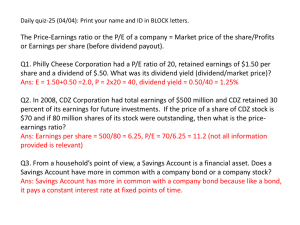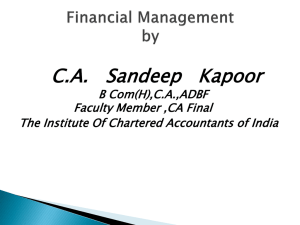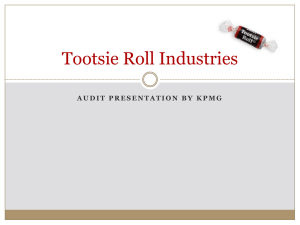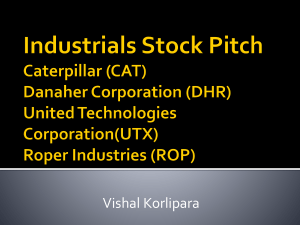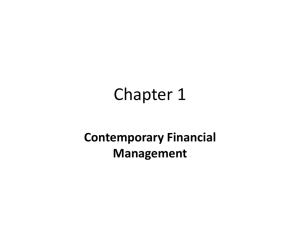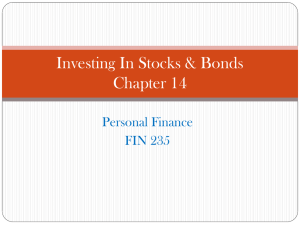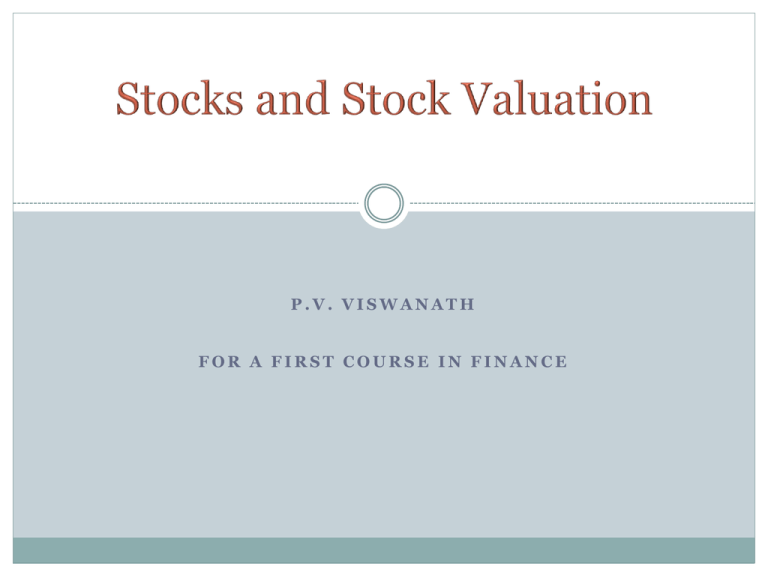
P.V. VISWANATH
FOR A FIRST COURSE IN FINANCE
2
What determines the price of a stock? Or, in other words,
why would an investor hold stocks?
One answer is that s/he expects to receive dividends and
hopefully benefit from a price increase, as well.
In other words, P0 = PV(D1) + PV(P1) , where P0 is the price
today and P1 is the price tomorrow.
If we use k to denote the appropriate rate to discount the
future dividend and the future stock price, then we can
write:
D 1 P1
P0
1 k
This can be rewritten to obtain:
k
D1
P1 P0
P0
P0
where the first term on the right
is the dividend yield and the second term the capital gains
component and k can be interpreted as the total return to the
investor.
P.V. Viswanath
3
However what determines P1?
Again, using the previous logic, we must say that it’s the
expectation of a dividend in period 2 and hopefully a further
price rise. Continuing, in this vein, we see that the stock price
must be the sum of the present values of all future dividends.
P0
D1
1 k
D2
(1 k )
2
...
Dn
(1 k )
n
...
We assume that the one-period ahead discount rate is the same
for all periods. That is, we use the same rate to discount D1 to
time 0, as we use to discount D2 to time 1.
One implication of this is that the price of the stock is the same
independent of the horizon of the particular investor.
P.V. Viswanath
4
If we assume that the dividend is growing at a
rate of g% per annum forever, this formula
simplifies to:
D1
P0
kg
•
We see that the price of a stock is higher, the
higher the level of dividends, the higher the
growth rate of dividends and the lower the
required rate of return or the discount rate, k.
P.V. Viswanath
5
Dividends = Earnings – Net New Investment
Hence a firm’s stock price cannot be the present
value of discounted earnings!
Unless the firm needs no new investment to maintain its
earnings.
What determines the price of the stock of a
company that reinvests part of its earnings?
We will see that it is the possibility of investing in
NPV>0 projects that allows the price of a stock to
be simply greater than the present value of its
earnings.
P.V. Viswanath
6
Suppose a firm starts out with a certain stock of
investment capital, I0 at the beginning of period 1
(end of period 0).
Assume that it earns a return, ROE, on this
capital, so as to assure it of earnings of $E1 each
period forever.
Assume, furthermore, that this firm pays out all
of these earnings as dividends, each period.
Then, its stock price today, P0 will be equal to
E1/k.
P.V. Viswanath
7
Now assume, in addition to its existing investments,
that the firm expects to have at t=1, an investment
opportunity with a t=1 value of $M1 (that is, this is the
present value at t=1 of all the future cashflows that will
be generated by this investment opportunity.
Implementation of this idea requires additional capital
of DI1=I1-I0, which the firm raises from the
marketplace.
If the capital market is efficient, the firm will have to
pay for this additional capital with promises of future
cashflows with a present value equal to the amount of
additional capital raised, DI1.
P.V. Viswanath
8
Hence the t=1 value that will accrue to the firm’s shareholders
is only M1- DI1.
Denote by NPV1, the t=0 value of M1- DI1. That is, NPV1= (M1DI1)/(1+k).
Taking this additional investment opportunity into account,
the firm’s stock price will not just be E1/k, but E1/k + NPV1.
Similarly, let NPVi represent the t=0 value of investment
opportunities that the firm expects to have a time t=i, for each
future time period.
Proceeding thus, we see that P0 = E1/k + NPVGO, where
NPVGO = S NPVi for all i = 2,…
Up to this point, we have assumed that the firm has raised this
additional capital from other investors in the market place.
P.V. Viswanath
9
Suppose, however, that the firm raises the additional capital in
period 1 from its own shareholders, by reducing the amount of
dividends that it pays in future periods.
If the new investment is obtained at t=1, then D1 = E1 – DI1.
Else it will be obtained by reducing dividends at various points in
the future.
These reductions in dividends will cause the stock price to drop by
an amount equal to the present value of DI1. However, the firm
will no longer have to pay the outside investors future
compensation for the contribution of the additional capital, DI1.
These two quantities must cancel each other out because its own
shareholders are no different from outside shareholders and will
require the same rate of return on their investments. We, see,
therefore, that P0 = E1/k + NPVGO.
P.V. Viswanath
10
That is, it is the possibility of investing in NPV>0 projects that
allows the price of a stock to be greater than the present value
of its earnings.
Retention of earnings by a firm for reinvestment will not
increase in a higher stock price if that additional investment
has a zero NPV. Or more precisely, the stock price will be
higher only by the amount retained in the current period and
not paid out.
That is, if the firm earns a return no greater than the rate of
return required by the market on financial investments of
similar risk already available to investors in the marketplace,
NPVGO = 0 and P0 will be equal to E1/k.
It is not the firm’s dividend policy that causes the firm’s stock
price to be higher, but rather the availability of positive NPV
investment opportunities.
This can be seen clearly in the following example.
P.V. Viswanath
11
Stellar, Inc. has decided to invest $10 m. in a new
project with a NPV of $20 m., but it has not made
an announcement.
The company has $10 m. in cash to finance the
new project.
Stellar has 10 m. shares of stock outstanding,
selling for $24 each, and no debt.
Hence, its aggregate value is $240 m. prior to the
announcement ($24 per share).
P.V. Viswanath
12
Two alternatives:
For both alternatives, we will see that the investor
ends up in the same situation, thus proving
dividend irrelevance.
One, pay no dividend and finance the project with
cash.
The value of each share rises to $26 following
the announcement. Each shareholder can sell
0.0385 (= 1/26) shares to obtain a $1 dividend,
leaving him with .9615 shares value at $25 (26
x 0.9615). Hence the shareholder has one share
worth $26, or one share worth $25 plus $1 in
cash.
P.V. Viswanath
13
Two, pay a dividend of $1 per share, sell $10m. worth of new
shares to finance the project.
After the company announces the new project and pays
the $1 dividend, each share will be worth $25.
To raise the $10 m. needed for the project, the company
must sell 400,000 (=10,000,000/25) shares.
Immediately following the share issue, Stellar will have
10,400,000 shares trading for $25 each, giving the
company an aggregate value of 25 x 10,400,000 =
$260m.
If a shareholder does not want the $1 dividend, he can
buy 0.04 shares (1/25).
Hence, the shareholder has one share worth $25 and $1
in dividends, or 1.04 shares worth $26 in total.
P.V. Viswanath
14
What are the determinants of growth in a firm’s earnings?
Earnings in any period depends on the investment base, as well
as the rate of return that the firm earns on that investment base:
Et+1 = (It)ROE
= (It-1 + DIt)(ROE), where DIt is the increment in investment
in period t over and above that in period t-1.
= (It-1)ROE + (DIt)(ROE)
= Et + (DIt)(ROE);
Hence Et+1 - Et = (DIt)(ROE)
Dividing both sides by Et , we get gt = (Retention Ratio)(ROE),
assuming that the additional investment is made possible by
retaining part of the firm’s earnings.
Hence the growth rate depends on the ROE as well as on the
retention ratio.
P.V. Viswanath
15
The DDM has two shortcomings:
Investors can obtain returns not only from dividends, but also from share
repurchases.
It is difficult to predict future dividends.
There are two alternative approaches to the DDM: the Total Payout
Model and the Free Cashflow Model
In the Total Payout Model, we allow not only for dividend
payments, but also future share repurchases. This is valid because a
share repurchase is simply an alternate way of distributing earnings.
However, if future share repurchases are made at the market price,
then the price per share should not be affected. This is the implicit
assumption in the Dividend Discount Model.
It is much easier to do this in terms of the entire firm, rather than
per share.
P0
PV ( Future Total Dividends
and Repurchase
Shares Outstandin
g0
s)
16
We analyze the Free Cashflow Model by first by noting that
Enterprise Value is the sum of the values of Equity and Debt
less Cash, under the implicit assumption that the firm does
not need cash to run its operations, which may not always be
true.
Enterprise Value MktValue (Equity) Debt Cash
The Enterprise itself is simply the present value of the free
cashflows to all security holders of the firm generated from
the operations of the firm.
That is, the cashflows that are available for distribution after
considering short-term and long-term reinvestment outlays.
17
We then note that
P0
V 0 Cash
SharesOuts
0
Debt
tanding
0
0
where V0 is the present value of the future free cashflows to the firm.
Noting that the discount rate to compute V0 is not the cost of capital,
but rather the weighted average cost of capital (WACC), which
represents the cost of raising funds from all security holders, not
equity alone, we can write:
This is equivalent to the DDM if the amount of dividends paid is equal
to the free cashflow.
18
Copyright © 2009 Pearson Prentice
Hall. All rights reserved.
19
Copyright © 2009 Pearson Prentice
Hall. All rights reserved.
20
Copyright © 2009 Pearson Prentice
Hall. All rights reserved.
21
This method also uses the Law of One Price, but in a
more direct manner.
We compute the “price” of a dollar of some flow
variable, such as earnings or EBITDA or Sales, using
the market valuations of comparable firms based on
the same flow variable.
We then multiply the forecasted value of the flow
variable for our firm by this “price.”
The most common flow variable used is the firm’s
earnings or Net Income per share.
22
A firm’s P/E ratio can be computed either by using
trailing earnings (last 12 months’ earnings) or forward
earnings (expected earnings over the next 12 months).
For valuation, the forward P/E ratio is preferred.
We compute the average forward P/E ratio for a sample
of comparable firms, estimate our firm’s earnings for the
next year and multiply it by the computed average P/E
ratio to get our firm’s price estimate.
We can relate the P/E ratio to the DDM, as below. This
shows that the higher the growth rate in earnings, the
higher the P/E ratio.
23
Valuation Multiples are also computed based on the firm’s
enterprise value.
Since enterprise value is the value of the entire firm, the
flow variable used would be something that applies to the
entire firm, e.g. EBITDA (earnings before interest, taxes,
depreciation and amortization) or free cashflow.
However, free cashflow is a very lumpy variable since
capital expenditures are lumpy. Hence, EBITDA is more
commonly used.
We can relate the EBITDA multiple to the FCF model, as
below. We see that the higher the growth rate of FCF, the
higher the EBITDA multiple.
24
Multiples are easy to use.
However, if the comparables are not picked correctly, the
“price” will be wrong.
The multiples will differ according to growth rates and
other firm-specific variables.
It is difficult to find firms that have the same variable
values (such as growth rate) as the firm to be priced.
Discounted Value approaches require the analyst to lay
out all assumptions fully – little is implicit.
The market price is brought in through the required rate
of return (which reflects the price of risk).
Ultimately, then, the choice is between which “price” the
analyst feels comfortable with.
25
Note that both approaches use market information
to generate a price. Hence we are interested in how
correct the market is in valuing assets.
The EMH says that an asset’s current price reflects
all available information.
The argument is that if it didn’t, there would be an
incentive for investors to act on that information.
Suppose, for example, that investors noticed that
good news led to stock prices rising slowly over two
consecutive days.
This would mean that at the end of the first day, the
good news was not all incorporated in the stock
price.
P.V. Viswanath
26
In this situation, it would be optimal for traders to buy even
more of a stock that was noted to be rising on a given day,
since the stock would rise more the next day, giving the
trader an unusually good chance of making money on the
trade.
But if many traders pursue this strategy, the stock price
would rise on the first day, itself, and the informational
inefficiency would be eliminated.
Empirically, financial markets seem to be reasonably close
to being efficient.
This allows us to price financial assets with respect to
fundamentals without worrying about deviations from these
fundamental prices.
P.V. Viswanath
27
This hypothesis is reasonable with respect to publicly
available information.
However, private information is generally
incorporated in prices only when it becomes public.
On the other hand, when private information
becomes public, it is incorporated fairly rapidly into
the asset price and the relationship between the
information released and the market reaction seems
appropriate.
Here are some examples of market reactions to
investment announcements.
28
From Prof. Aswath Damodaran’s textbook, “Corporate Finance”
Abnormal Returns on
Type of Announcement
Announcement Day
Announcement Month
Joint Venture Formations
0.399%
1.412%
R&D Expenditures
0.251%
1.456%
Product Strategies
0.440%
-0.35%
Capital Expenditures
0.290%
1.499%
All Announcements
0.355%
0.984%
P.V. Viswanath
29
We can see that the market reacts to information by
looking at how stock prices move when there is new
information.
However, there are many things happening in the
economy and in the world and it is not always easy to see
why prices are changing.
One way would be to look at a specific category or group
of similar events and then see if the market behaves
similarly.
One study done by the Federal Reserve looks at the
market’s reaction to Fed Reserve Open Market
Committee statements.
On June 19, 2013, the Fed released a statement following
the FOMC meeting.
30
The NY Times of the following day reported as follows:
The Federal Reserve, increasingly confident in the durability of
economic growth, expects to start pulling back later this year from its
efforts to stimulate the economy, the Fed chairman, Ben S.
Bernanke, said on Wednesday.
Mr. Bernanke’s comments, which followed a two-day meeting of the
Fed’s policy-making committee, appeared to disappoint investors on
Wall Street who had hoped that the central bank would do more for
longer. Stocks fell, with the broad Standard & Poor’s 500-stock index
dropping 1.39 percent; interest rates rose.
Perhaps these market moves were a coincidence? Can we
say that this was a result of Chairman Bernanke’s
comments?
31
In fact, there are strong reasons to believe so, as the
following graph shows:
32
In fact, the study by Fernando Duarte and Carlo Rosa of
the NY Fed looked at the volatility of stock prices around
the release of FOMC statements and found that volatility
spiked around the time of the release and during the
press conference. Since this evidence is not from a single
press conference, but rather the average of the four
FOMC meetings in 2012, it looks like the market always
reacts to news.
This is true not only of the equity market, but also of the
bond market (and also of the foreign exchange market).
This can be seen in the following graph:
libertystreeteconomics.newyorkfed.org/2013/11/a-way-with-words-theeconomics-of-the-feds-press-conference.html
33
34
When information is not public but can be obtained
through some effort or when the implications of the
publicly available information are difficult to figure out,
there may be value for analysts to search out new
information or to interpret publicly available
information.
However, the greater the value of such analysis, the
greater will the supply of analysts.
This should lead to competition for the gains to such
analysis.
Consequently, in the long run, the market “inefficiency”
will be limited only by the costs of obtaining information
or analyzing the information.
35
Investors can identify NPV>0 trading opportunities
(i.e. find “mispriced” assets) only if:
The investor has access to information that is know only to a
few people or
He has special expertise in analyzing information.
Corporate Managers should
Focus on finding NPV>0 business investment opportunities.
Avoid accounting illusions, such as manipulating accounting
earnings.
Use capital markets wherever possible to take advantage of
NPV>0 business investment opportunities.


